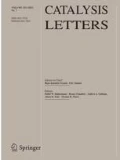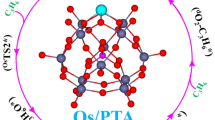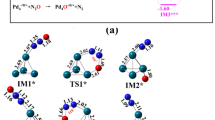Abstract
The density functional theory (DFT) has been employed to investigate the initial stages of NH3 and NO adsorption on both Lewis and Brønsted acid sites of (Mo2O5)2+/HZSM-5 by using cluster models. The calculated results reveal that NH3 can strongly adsorb on both Lewis and Brønsted acid sites in the form of coordinated NH3 and NH4 + and the corresponding adsorption energies are − 48.16 and − 37.28 kcal/mol, respectively. Compared with NH3, NO represents much poorer adsorption ability on both Lewis and Brønsted acid sites. Upon NH3 adsorption on Lewis acid site, its connected Mo site converts to sixfold coordination and octahedral structure while the other Mo site still remains fivefold coordination and tetrahedral structure and electronic structure. However, NH3 adsorption on Brønsted acid site leads to the decrease of stability and the increase of reactivity of the two fivefold coordinated Mo sites. Along the proposed reaction mechanisms, the results of NO adsorption on (Mo2O5)2+/HZSM-5 with adsorbed NH3 indicate that NO can be adsorbed on the second unsaturated fivefold Mo site for both Lewis and Brønsted acid sites and be activated, which weaken the interaction between adsorbed NH3 species and (Mo2O5)2+/HZSM-5.
Graphical Abstract










Similar content being viewed by others
References
Busca G, Lietti L, Ramis G, Berti F (1998) Chemical and mechanistic aspects of the selective catalytic reduction of NOx by ammonia over oxide catalysts: a review. Appl Catal B 18:1–36
Centi G, Perathoner S (2007) Chap. 1 Introduction: state of the art in the development of catalytic processes for the selective catalytic reduction of NOx into N2, In: Granger P, Pârvulescu VI (eds) Stud. Surf. Sci. Catal, Elsevier, pp. 1–23
L. Lietti, I. Nova, G. Ramis, L. Dall’Acqua, G. Busca, E. Giamello, P. Forzatti, F. Bregani, Characterization and reactivity of V2O5–MoO3/TiO2 De-NOx SCR catalysts. J Catal. 187 (1999) 419–435.
Casagrande L, Lietti L, Nova I, Forzatti P, Baiker A (1999) SCR of NO by NH3 over TiO2-supported V2O5–MoO3 catalysts: reactivity and redox behavior. Appl Catal B 22:63–77
Mhamdi M, Ghorbel A, Delahay G (2009) Influence of the V + Mo/Al ratio on vanadium and molybdenum speciation and catalytic properties of V–Mo–ZSM-5 prepared by solid-state reaction. Catal Today 142:239–244
Wang XP, Yu SS, Yang HL, Zhang SX (2007) Selective catalytic reduction of NO by C2H2 over MoO3/HZSM-5. Appl Catal B 71:246–253
A.L.S.M. Salgado, Passos FB, Schmal M (2003) NO reduction by ethanol on Pd and Mo catalysts supported on HZSM-5. Catal Today 85:23–29
Z. Li, W. Huang, K.-C. Xie (2005) Effect of Mo contents on properties of Mo/ZSM-5 zeolite catalyst for NOx reduction J Environ Sci. 17 103–105.
Z. Li, K.C. Xie, W. Huang, W. Reschetilowski(2005) Molybdenum loaded on HZSM-5: a catalyst for selective catalytic reduction of nitrogen oxides, Stud Surf Sci Catal. 158 1741–1748.
Z. Li, W. Huang, K.C. Xie (2002) Selective catalytic reduction of NO over Mo/ZSM-5 catalyst. Chin J Catal 23 535–538.
Yu W, Zhu J, Qi L, Sun C, Gao F, Dong L, Chen Y (2011) Surface structure and catalytic properties of MoO3/CeO2 and CuO/MoO3/CeO2. J Colloid Interface Sci 364:435–442
Peng Y, Qu R, Zhang X, Li J (2013) The relationship between structure and activity of MoO3-CeO2 catalysts for NO removal: influences of acidity and reducibility. Chem Commun 49:6215–6217
Ding W, Li S, Meitzner GD, Iglesia E (2000) Methane conversion to aromatics on Mo/H-ZSM5: structure of molybdenum species in working catalysts. J Phys Chem B 105:506–513
Borry RW, Kim YH, Huffsmith A, Reimer JA, Iglesia E (1999) Structure and density of Mo and acid sites in Mo-exchanged H-ZSM5 catalysts for non oxidative methane conversion. J Phys Chem B 103:5787–5796
W. Ding, G.D. Meitzner, E. Iglesia(2002) The effects of silanation of external acid sites on the structure and catalytic behavior of Mo/H–ZSM5. J Catal 206 14–22.
W. Li, G.D. Meitzner, R.W. Borry Iii, E. Iglesia(2000) Raman and X-Ray Absorption studies of Mo species in Mo/H-ZSM5 catalysts for non-oxidative CH4 reactions. J. Catal 191 373–383.
Savinelli RO, Scott SL (2010) Wavelet transform EXAFS analysis of mono- and dimolybdate model compounds and a Mo/HZSM-5 dehydroaromatization catalyst. Phys Chem Chem Phys 12:5660–5667
Y.-H. Kim, R.W. Borry Iii, E. Iglesia(2000) Genesis of methane activation sites in Mo-exchanged H–ZSM-5 catalysts. Micropor Mesopor Mater 35–36 495–509.
B. Li, S. Li, N. Li, H. Chen, W. Zhang, X. Bao, B. Lin(2006) Structure and acidity of Mo/ZSM-5 synthesized by solid state reaction for methane dehydrogenation and aromatization, Micropor Mesopor Mater 88 244–253.
Z.R. Ismagilov, E.V. Matus, L.T. Tsikoza.(2008) Direct conversion of methane on Mo/ZSM-5 catalysts to produce benzene and hydrogen: achievements and perspectives. Energy Environ Sci 1 526–541.
Ma D, Zhu Q, Wu Z, Zhou D, Shu Y, Xin Q, Xu Y, Bao X (2005) The synergic effect between Mo species and acid sites in Mo/HMCM-22 catalysts for methane aromatization. Phys Chem Chem Phys 7:3102–3109
Ma D, Han X, Zhou D, Yan Z, Fu R, Xu Y, Bao X, Hu H, S.C.F. Au-Yeung (2002) Towards guest-zeolite interactions: an NMR spectroscopic approach. Chem Eur J 8:4557–4561
H. Minming, R.F. Howe, Characterization of MoY zeolites prepared by aqueous ion exchange. J Catal 108 (1987) 283–293.
Zhou D, Ma D, Liu X, Bao X (2001) Study with density functional theory method on methane dehydro-aromatization over Mo/HZSM-5 catalysts I: optimization of active Mo species bonded to ZSM-5 zeolite. J Chem Phys 114:9125–9129
D. Ma, Y. Shu, X. Bao, Y. Xu(2000) Methane dehydro-aromatization under nonoxidative conditions over Mo/HZSM-5 catalysts: EPR study of the Mo species on/in the HZSM-5 zeolite. J Catal 189 314–325.
Xu Y, Liu S, Guo X, Wang L, Xie M (1994) Methane activation without using oxidants over Mo/HZSM-5 zeolite catalysts. Catal Lett 30:135–149
L.A. Pine, P.J. Maher, W.A. Wachter(1984) Prediction of cracking catalyst behavior by a zeolite unit cell size model. J Catal 85 466–476.
Zhou D, Ma D, Wang Y, Liu X, Bao X (2003) Study with density functional theory method on methane C–H bond activation on the MoO2/HZSM-5 active center. Chem Phys Lett 373:46–51
Tessonnier J-P, Louis B, Rigolet S, Ledoux MJ, Pham-Huu C (2008) Methane dehydro-aromatization on Mo/ZSM-5: about the hidden role of Brønsted acid sites. Appl Catal A 336:79–88
Tessonnier J-P, Louis B, Walspurger S, Sommer J, Ledoux M-J, Pham-Huu C (2006) Quantitative measurement of the Brönsted acid sites in solid acids: toward a single-site design of Mo-modified ZSM-5 zeolite. J Phys Chem B 110:10390–10395
M.J. Rice, A.K. Chakraborty, A.T. Bell (1999)Al next nearest neighbor, ring occupation, and proximity statistics in ZSM-5. J Catal 186:222–227.
Yan Z, Zuo Z, Li Z, Zhang J (2014) A cluster DFT study of NH3 and NO adsorption on the (MoO2)2+/HZSM-5 surface: Lewis versus Brønsted acid sites. Appl Surf Sci 321:339–347
Calatayud M, Mguig B, Minot C (2004) Modeling catalytic reduction of NO by ammonia over V2O5, Surf. Sci Rep 55:169–236
Busca G, Larrubia MA, Arrighi L, Ramis G (2005) Catalytic abatement of NOx: Chemical and mechanistic aspects. Catal Today 107–108:139–148
H. Yao, Y. Chen, Z. Zhao, Y. Wei, Z. Liu, D. Zhai, B. Liu, C. Xu(2013) Periodic DFT study on mechanism of selective catalytic reduction of NO via NH3 and O2 over the V2O5 (001) surface: Competitive sites and pathways J. Catal 305:67–75.
Soyer S, Uzun A, Senkan S, Onal I (2006) A quantum chemical study of nitric oxide reduction by ammonia (SCR reaction) on V2O5 catalyst surface. Catal Today 118:268–278
Cao F, Su S, Xiang J, Sun L, Hu S, Zhao Q, Wang P, Lei S (2012) Density functional study of adsorption properties of NO and NH3 over CuO/γ-Al2O3 catalyst. Appl Surf Sci 261:659–664
R.Q. Long, R.T. Yang(2002) Reaction mechanism of selective catalytic reduction of NO with NH3 over Fe-ZSM-5 catalyst. J. Catal 207:224–231.
D. Fang, F. He, D. Li, J. Xie(2013) First principles and experimental study of NH3 adsorptions on MnOx surface. Appl Surf Sci 285:215–219.
Lowenstein W (1954) The distribution of aluminium in the tetrahedra of silicates and aluminates. Am Mineral 39:92–96
Zhou D, Zhang Y, Zhu H, Ma D, Bao X (2007) The structure, stability, and reactivity of Mo-oxo species in H-ZSM5 Zeolites: density functional theory study. J Phys Chem C 111:2081–2091
Delley B (1990) An all-electron numerical method for solving the local density functional for polyatomic molecules. J Chem Phys 92:508–517
Delley B (1996) Fast calculation of electrostatics in crystals and large molecules. J Phys Chem 100:6107–6110
Perdew JP, Wang Y (1992) Accurate and simple analytic representation of the electron-gas correlation energy. Phys Rev B 45:13244–13249
Dolg M, Wedig U, Stoll H, Preuss H (1987) Energy-adjusted abinitio pseudopotentials for the first row transition elements. J Chem Phys 86:866–872
Bergner A, Dolg M, Küchle W, Stoll H, Preuß H (1993) Ab initio energy-adjusted pseudopotentials for elements of groups 13–17. Mol Phys 80:1431–1441
Mulliken RS (1955) Electronic population analysis on LCAO–MO molecular wave functions. I. J Chem Phys 23:1833–1840
Mulliken RS (1955) Electronic population analysis on LCAO–MO molecular wave functions. II. Overlap populations, bond orders, and covalent bond energies. J Chem Phys 23:1841–1846
Mulliken RS (1955) Electronic population analysis on LCAO-MO molecular wave functions. III. Effects of hybridization on overlap and gross AO populations. J Chem Phys 23:2338–2342
Mulliken RS (1955) Electronic population analysis on LCAO-MO molecular wave functions. IV. Bonding and antibonding in LCAO and valence-bond theories. J Chem Phys 23:2343–2346
Mayer I (1983) Charge, bond order and valence in the AB initio SCF theory. Chem Phys Lett 97:270–274
I. Mayer, Bond orders and valences: role of d-orbitals for hypervalent sulphur. J Mol Struct THEOCHEM 149 (1987) 81–89.
Tsumuraya T, Shishidou T, Oguchi T (2007) First-principles study on lithium and magnesium nitrogen hydrides for hydrogen storage. J Alloys Compd 446–447:323–327
Lide DR (2000) CRC Handbook of chemistry and physics. CRC Press, Boca Raton
Schröder K.-P, Sauer J, Leslie M, Richard C, Catlow A (1992) Siting of AI and bridging hydroxyl groups in ZSM-5: a computer simulation study. Zeolites 12:20–23.
Nachtigallova D, Nachtigall P, Sierka M, Sauer J (1999) Coordination and siting of Cu+ ions in ZSM-5: a combined quantum mechanics/interatomic potential function study. Phys Chem Chem Phys 1:2019–2026
Sierka M, Sauer J (1997) Structure and reactivity of silica and zeolite catalysts by a combined quantum mechanics[ndash]shell-model potential approach based on DFT. Faraday Discuss 106:41–62
Illas F, López N, García-Hernández M, de P.R. Moreira I (1998) Theoretical study of NH3 chemisorption on Pt(111). J Mol Struct THEOCHEM 458:93–98.
García-Hernández M, López N, d.P.R. Moreira I, Paniagua JC, Illas F (1999) Ab initio cluster model approach to the chemisorption of NH3 on Pt(111). Surf Sci 430:18–28
Diawara B, Joubert L, Costa D, Marcus P, Adamo C (2009) Ammonia on Ni(111) surface studied by first principles: bonding, multi layers structure and comparison with experimental IR and XPS data. Surf Sci 603:3025–3034
Lanzani G, Laasonen K (2010) NH3 adsorption and dissociation on a nanosized iron cluster. Int J Hydrogen Energy 35:6571–6577
Liu R, Shen W, Zhang J, Li M (2008) Adsorption and dissociation of ammonia on Au(111) surface: a density functional theory study. Appl Surf Sci 254:5706–5710
Anstrom M, Topsøe N.Y, Dumesic J.A. (2003) Density functional theory studies of mechanistic aspects of the SCR reaction on vanadium oxide catalysts. J Catal 213:115–125.
Cheng D, Lan J, Cao D, Wang W (2011) Adsorption and dissociation of ammonia on clean and metal-covered TiO2 rutile (110) surfaces: a comparative DFT study. Appl Catal B 106:510–519
Hadjiivanov K (1998) FTIR study of CO and NH3 co-adsorption on TiO2 (rutile). Appl Surf Sci 135:331–338
Papakondylis A, Sautet P (1996) Ab initio study of the structure of the α-MoO3 solid and study of the adsorption of H2O and CO molecules on its (100) surface. J Phys Chem 100:10681–10688
Yin X, Han H, Gunji I, Endou A, Cheettu Ammal SS, Kubo M, Miyamoto A (1999) NH3 adsorption on the Brönsted and Lewis acid sites of V2O5(010): a periodic density functional study. J Phys Chem B 103:4701–4706
Yao H, Chen Y, Wei Y, Zhao Z, Liu Z, Xu C (2012) A periodic DFT study of ammonia adsorption on the V2O5 (001), V2O5 (010) and V2O5 (100) surfaces: Lewis versus Brönsted acid sites. Surf Sci 606:1739–1748
Ramis G, Busca G, Bregani F, P. Forzatti* (1990) Fourier transform-infrared study of the adsorption and co adsorption of nitric oxide, nitrogen dioxide and ammonia on vanadia-titania and mechanism of selective catalytic reduction. Appl Catal 64:259–278
Pittman RM, Bell AT (1994) Raman investigations of NH3 adsorption on TiO2, Nb2O5, and Nb2O5/TiO2. Catal Lett 24:1–13
Acknowledgements
The authors thank reviewers for their valuable suggestions and the financial support from National Natural Science Foundation of China (No. 21073131), State Key Laboratory Breeding Base of Coal Science and Technology Co-founded by Shanxi Province and the Ministry of Science and Technology, Taiyuan University of Technology (No. MKX201301), the Key Technologies R&D Program of Shanxi Province of China (No. 20140313002-2) and Youth Foundation of Taiyuan University of Technology (No. 1205-04020202).
Author information
Authors and Affiliations
Corresponding author
Rights and permissions
About this article
Cite this article
Yan, Z., Shi, S., Li, Z. et al. The Initial Stages of NH3 and NO Adsorption On (Mo2O5)2+/HZSM-5 with Two Adjacent Unsaturated fiveFold Mo Sites in SCR Reaction: A Cluster DFT Study. Catal Lett 147, 1006–1018 (2017). https://doi.org/10.1007/s10562-017-2000-1
Received:
Accepted:
Published:
Issue Date:
DOI: https://doi.org/10.1007/s10562-017-2000-1




